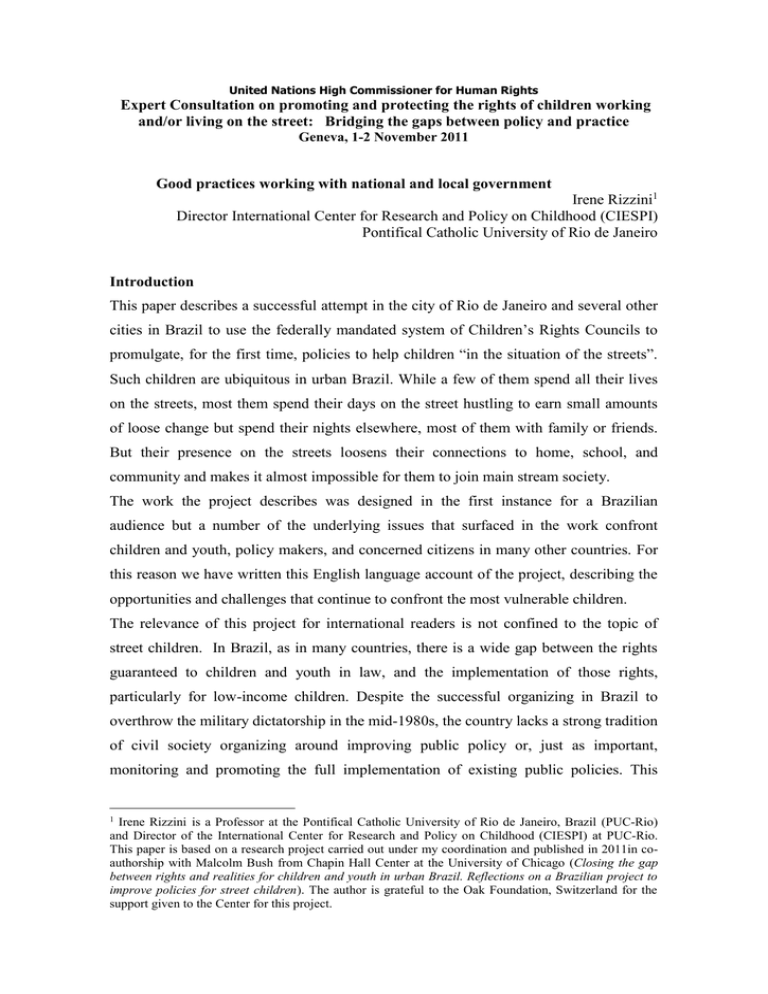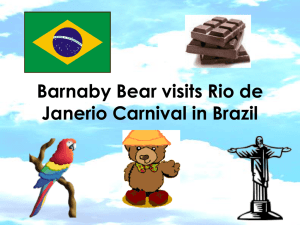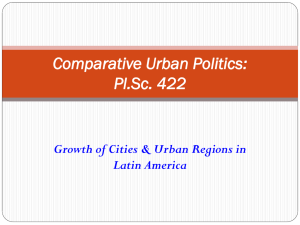Expert Consultation on promoting and protecting the rights of children... and/or living on the street: Bridging the gaps...
advertisement

United Nations High Commissioner for Human Rights Expert Consultation on promoting and protecting the rights of children working and/or living on the street: Bridging the gaps between policy and practice Geneva, 1-2 November 2011 Good practices working with national and local government Irene Rizzini1 Director International Center for Research and Policy on Childhood (CIESPI) Pontifical Catholic University of Rio de Janeiro Introduction This paper describes a successful attempt in the city of Rio de Janeiro and several other cities in Brazil to use the federally mandated system of Children’s Rights Councils to promulgate, for the first time, policies to help children “in the situation of the streets”. Such children are ubiquitous in urban Brazil. While a few of them spend all their lives on the streets, most them spend their days on the street hustling to earn small amounts of loose change but spend their nights elsewhere, most of them with family or friends. But their presence on the streets loosens their connections to home, school, and community and makes it almost impossible for them to join main stream society. The work the project describes was designed in the first instance for a Brazilian audience but a number of the underlying issues that surfaced in the work confront children and youth, policy makers, and concerned citizens in many other countries. For this reason we have written this English language account of the project, describing the opportunities and challenges that continue to confront the most vulnerable children. The relevance of this project for international readers is not confined to the topic of street children. In Brazil, as in many countries, there is a wide gap between the rights guaranteed to children and youth in law, and the implementation of those rights, particularly for low-income children. Despite the successful organizing in Brazil to overthrow the military dictatorship in the mid-1980s, the country lacks a strong tradition of civil society organizing around improving public policy or, just as important, monitoring and promoting the full implementation of existing public policies. This 1 Irene Rizzini is a Professor at the Pontifical Catholic University of Rio de Janeiro, Brazil (PUC-Rio) and Director of the International Center for Research and Policy on Childhood (CIESPI) at PUC-Rio. This paper is based on a research project carried out under my coordination and published in 2011in coauthorship with Malcolm Bush from Chapin Hall Center at the University of Chicago (Closing the gap between rights and realities for children and youth in urban Brazil. Reflections on a Brazilian project to improve policies for street children). The author is grateful to the Oak Foundation, Switzerland for the support given to the Center for this project. project examines a mechanism that exists in Brazilian law, joint civil society and public sector policy oversight Councils, but also examines a number of other mechanisms for promoting and implementing better social policies. The project also raises the question of not only the most vulnerable children such as street children, but the much larger number of children who live in contexts of vulnerability and violence such as overcrowded, very poor, and otherwise unhealthy urban slums. As we present this work to an audience in other countries we are well aware of the strikingly different contexts that exist in different countries and different cultures. We do not believe that there are model programs for complex social problems that can transcend differences of culture, language, and local traditions. The dream of global solutions is not realistic. But we have learned a great deal from colleagues in other countries including seeing our own countries in a richer perspective. We hope the Brazilian experience can help others struggling with the issue of how to help children in vulnerable contexts make a successful passage to adulthood. Our experience can also illuminate the more challenging issue of helping those children and youth who have lost, or are losing contact with family, friends and community. The project was conducted at the International Center for Research and Policy on Childhood (CIESPI) at the Pontifical Catholic University of Rio de Janeiro (PUC-Rio). For over twenty years, CIESPI has been conducting under my coordination applied research and providing technical assistance to improve policies and practices for children and youth, their families and the communities in which they live. We hope that this paper will be useful to our international colleagues and we look forward to continuing our dialogue with them about how to improve the lives of vulnerable children. Closing the gap between rights and realities for children and youth in urban Brazil. Reflections on a Brazilian project to improve policies for street children This paper describes successful attempts in Rio de Janeiro and several other cities in Brazil to develop, for the first time, policies to assist street children through the federally mandated mechanism of Children’s Rights Councils. In Brazil there is a wide gap between legal rights guaranteed to children and their daily lives. The subject of our concern, children in the situation of the streets, refers to urban children who fall into two groups: a small group who spend their days and nights on the street; and a much larger group who spend their days on the street hustling for loose change and hanging out, but who spend their nights in a variety of unstable accommodations off the streets. The situation of vulnerable children in urban Brazil While the last twenty years have seen improvements in some child indicators including reductions in infant mortality and increases in the percent of young children attending school, many children still suffer from poverty, violence, poor education, and slum living conditions. In 2010, nine million people in Brazil had incomes of less than R$127 (reais) or US$78 a month. The murder rate of youth aged twelve to eighteen in 2007 was 24.1 per 100,000 and for black youth in the city of Rio a horrifying 300 per 100,000. The highest rates of violence are found in low-income communities which suffer from heavily armed drug traffickers, vigilante militias and violent police action. Most children in Brazil only go to school for half a day because of resource shortages. Drop-out rates and the rates of children scoring below grade level are very high. Children in the situation of the streets in Rio de Janeiro and in urban Brazil The Federal Government recently released a draft of the first-ever national census and sample survey of street children. The Census counted some 23,973 children and adolescents in the situation of the streets with just over 5,000 in the state of Rio de Janeiro. Twenty nine percent of the children were between the ages of sixteen and seventeen, 45% were between twelve and fifteen, 23% were between six and eleven years of age and the rest were between zero and five. Almost three-quarters were male. The majority of the sample was living either with their parents, relatives or friends (57%). Most of the rest were living in “other places” but not on the streets. Four percent were “of” the streets, that is they spent all day and all night on the streets. Relationships between children “on” the streets and their parents varied. While 30% of the sample “on” the streets reported no contact with their parents, 48% saw their parents at least several times a month. But a majority of these children had no or bad relations with their parents. The survey draws a stark picture of life on the streets and in “other places”. Most children on the streets have been there for a long time. Twenty-four percent sleeping outside of their homes had been on the streets for between two and five years. Life on the streets is a constant hustle. Just about everyone on the streets had some way of earning money including selling small items, cleaning car windows and begging. Sixteen percent of the young women said they earned money through prostitution. Despite this level of hustling, economically life on the streets is most precarious. About twenty-eight of the total said they did not eat every day. Life on the streets is also disconnected to the avenues for returning to the mainstream. Only 24% of the sixteen to seventeen year olds had completed elementary school. All this spells a very grim future which includes the constant danger of harassment and violence. Children’s rights in Brazil Current legal rights for children in Brazil date from the 1988 Constitution and the 1990 Statute on the Child and the Adolescent. The Statute provided for the first time that children were “the subject of rights” with additional rights to protect their full development. The Statute ended the former emphasis in law of children as threats to public order. The Statute also contained a startlingly innovative mechanism for implementing children’s rights, namely Children’s Rights Councils at the national, state and municipal levels. Implementing children’s rights in Brazil: Children’s Rights Councils The system of Councils (and there are different Councils on different topics) is unique to post-dictatorship Brazil. Part-public, part (elected) civil society councils with federally mandated powers to debate public policy is an unusual phenomenon. A key characteristic of these Councils is parity between public and civil society representatives. Children’s Rights Councils, unlike most other policy councils, can formulate policy in addition to consult on and monitor policy. The research project CIESPI undertook a systematic analysis of the process of developing policies in Rio de Janeiro and six other cities. These cities were chosen to represent at least one state in each of the macro-regions of Brazil. Three cities adopted policies or plans on street children during the period of the project: Rio de Janeiro, São Luis and Recife. The Recife Plan also includes provisions for implementation. The analyses included collecting data about the condition of street children, participant observation in the Councils and their key committees, two national conferences with participants from the cities held in Rio de Janeiro, and systematic contacts with the participants outside Rio by on-site interviews, email and telephone. By design however, much of the work centered on the Rio process. In addition to monitoring the process of developing a policy on street children in Rio, CIESPI staff also provided data on street children, and advised the nonprofit participants on policy and strategy. The process of constructing a policy on street children in Rio de Janeiro The Council’s work on the policy officially began in July 2008 when the Council formed a Working Group to develop a policy. The nonprofit Rio Children’s Network took the most active role in mobilizing groups outside of the Council to press for the adoption of a policy. Three of its member organizations had seats on the Council. After delays caused by municipal elections, the Working Group presented the Policy to an extraordinary meeting of the Council on June 22, 2009. The assembly adopted the Policy at that meeting by a unanimous vote. The Policy The Policy sets out directives and responsibilities for eight municipal departments and for civil society in general. The directives are specific to the departments as, for example, the Health Department should develop strategies to prevent the spread of AIDS and other infectious diseases among street children. They can, however, be summarized as follows: 1. Target areas in the city with concentrations of street children to promote the children’s departure from the streets while respecting their wishes and their rights. 2. Take programs intended for a wider population and make sure they are provided to street children, their families, and friends. 3. Give street children priority in access to particular public resources. 4. Encourage street children’s use of public resources such as public education. 5. Provide special services for street children with special staff where necessary. 6. Make special provision for protecting street children against health risks and violence including better training for the police in human rights. The Policy separately lists the responsibilities of the “organizations of civil society” including monitoring the implementation of the Policy and advocating for the provision of adequate funding. A year after passage, the Council established an Implementation Commission which in January 2011 produced a plan for implementation including timelines for specific actions. Major findings Achievements 1. The Rio Council’s success in producing a policy Despite the lack of a history of developing and approving policies on children, the Rio Council produced a detailed policy on improving the lives of street children. The Policy contains concrete and actionable instructions for eight municipal departments. 2. The use of data on vulnerable children and street children The work of the Rio Council was based on a survey of current knowledge about street children and children living in vulnerable conditions specifically constructed for the debate in the Council. 3. The successful use of expertise and technical assistance from the university sector CIESPI staff provided assistance to the Working Group about how to record its work and on “how to move the agenda” in a way that permitted steady progress. 4. The Rio Council set up an implementation oversight committee and planned an implementation agenda The establishment of an implementation committee was a huge step forward in tackling the lack of precedents for monitoring and promoting the implementation of children’s policies. 5. The effective action of networks and coalitions In Rio, São Luis and Recife broadly-based children’s coalitions provided the energy and direction needed for the successful adoption of the policies. These coalitions are, however, fragile and increasing the resources they receive could achieve important benefits in improving public policy. 6. The Councils’ work on policies for street children represents a dramatic change from seeing street children as threats to public order The approach of constructing concrete policies to improve the lives of street children stands in a dramatic contrast to the prior lack of a formal policy but the practice of seeing street children as public menaces who simply need to be removed from the streets and controlled. Challenges 1. The lack of sustained debate and action on street children Street children are ubiquitous in urban Brazil. Despite this fact, in twenty years very few Councils have succeeded in addressing this problem. 2. The weight of responsibilities of Councilors and their lack of time Children’s Rights Councils are responsible for all matters referring to the rights of children and adolescents including the registration of all non-profit organizations that work with children. Moreover, Council positions are voluntary and Councilors only spend a few hours a week on their Counselor responsibilities. So many Councils have little time for policy issues. 3. Challenges posed by the public sector Councilors Many public sector representatives were from the same municipal department leaving other departments unrepresented. Public sector representatives were often junior employees and frequently rotated. They tended to know very little about the lives of street children. 4. Lack of experience in the role of policy making Many Councilors lacked experience of how to deliberate about and develop public policies. Many also lacked experience of acting and speaking in a public decisionmaking body. 5. Securing the involvement of children and youth While Brazilian law on children and youth and the values of many of the participants in the process stress the participation of children and youth in public discussions about their lives, such participation is hard to obtain. Some adults resist the involvement of the young people while other adults think they can represent children and youth despite the adults’ lack of contact with the young people. Vulnerable youth themselves can be reluctant to participate in public discussions out of lack of understanding, interest, or belief that their participation will make any difference. 6. The over-concentration on the disbursement of federal funds Many Councilors only participated in Council debates during discussions about the allocation of funds especially members belonging to religious bodies that received grants from the Council. 7. Services to children on the streets or strategies to re-attach children to families and communities? It is unclear whether street children will be able or wish to participate in the services and activities on offer. The Policies also emphasize the need to re-attach the children to families and communities. But this is an extraordinarily difficult task. Opportunities 1. The mandated role of Councils Councils exist in almost 6,000 municipalities in Brazil, have the federal legal mandate for adopting policies for children, and include key public and civil society actors. Having elected members of civil society, they enjoy more independence than government commissions. 2. The existence of institutional and other hooks to promote change Municipal governments could turn Council policy into law. More jurisdictions could adopt the practice of convening all stake holders to develop a priority agenda for improving the lives of street children. There are also reform moments including the election or appointment to public office of progressive officials. In Rio, the upcoming 2014 World Cup and the 2016 Olympic Games are opportunities to spotlight the vulnerable children in the city, and some groups are organizing around these opportunities. A resolution of the National Council on Children’s Rights provides that when a Council’s policy is not implemented the Council can request the Public Prosecutor to order adherence to the policy. 3. Building political support: External and internal allies Some federally mandated Councils in other policy areas appear to elicit broader support for their activities. Councils on Social Assistance were said to be effective because the bulk of the social assistance budgets passed through them. The actions of health Councils were supported by the doctors’ unions. Environmental Councils attracted the attention of environmental coalitions. 4. The opportunities of the budget process While public budgets in Brazil are opaque and lack detail, the budget process is a major opportunity for shaping public policies. Some nonprofit groups are showing interest in making budgets more transparent and using them as advocacy tools. Postscript While children in Brazil enjoy strong theoretical rights these rights are of comparatively recent origin and the implementation of these rights is weak particularly for vulnerable children. Street children suffer extensive violation of their rights. Brazilian law established a particular mechanism for promoting the implementation of rights, Children’s Rights Councils. Our study shows that Children’s Rights Councils can, in certain circumstances, develop detailed policies on street children, a step towards the implementation of rights. But there are other institutional actors, coalitions and responsible officials who can assist the development and implementation of policies for street children and other vulnerable children. No part of the collectivity of these actors should be ignored in the search for ways to give vulnerable children the chance to fully develop their capacities. Irene Rizzini is a Professor at the Pontifical Catholic University of Rio de Janeiro, Brazil (PUC-Rio) and Director of the International Center for Research and Policy on Childhood (CIESPI) at PUC-Rio. Professor Rizzini served as President of the Childwatch International Research Network from 2002 to 2009, a network of over forty university based research centers in over forty countries. She held the visiting chair in Brazilian Cultural Studies at the Helen Kellogg Institute for International Studies at the University of Notre Dame in 2006, and was appointed a John Simon Guggenheim Memorial Foundation fellow in 2008. She is the author of several books, among which are: Globalization and children, The art of governing children: the history of social policies, legislation and child welfare in Brazil, Disinherited from society: street children in Latin America, The lost century: the historical roots of public policies on children in Brazil, Images of the child in Brazil: the 19th and 20th centuries, Children and the law in Brazil- revisiting the History (1822-2000), The Human Rights of Children and Adolescents: Twenty years of the Statute (on Children and Adolescents in Brazil). Professor Rizzini received her Master's degree at the University of Chicago (School of Social Service Administration) and her Ph.D. in Sociology from Rio de Janeiro Institute of Research (IUPERJ). In 1984, Professor Rizzini founded the Center for Research on Children (CESPI) at Santa Ursula University in Rio which became the International Center for Research and Policy on Childhood (CIESPI) at PUC-Rio in 2002.





